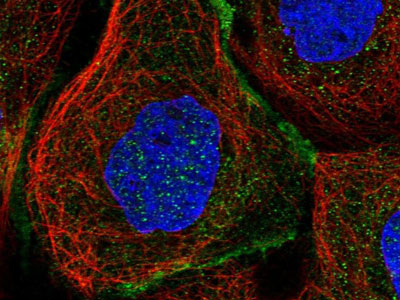Diabetes:开启特殊基因可抑制糖尿病发生
| 导读 |
II 型糖尿病患者的胰岛素耐受性部分是由于机体缺少某种蛋白质所致,而这种特殊蛋白质和糖尿病并无关系。
现在,来自蒙特利尔大学等机构的研究人员研发出了一种可帮助开发有效抑制糖尿病发生的疗法。相关研究论文刊登在了近期出版的《糖尿病》(Diabetes)杂志上。
II 型糖尿病占据了全世界糖尿病人群中的 90%,影响着 250 万加拿大人... |

II 型糖尿病患者的胰岛素耐受性部分是由于机体缺少某种蛋白质所致,而这种特殊蛋白质和糖尿病并无关系。
现在,来自蒙特利尔大学等机构的研究人员研发出了一种可帮助开发有效抑制糖尿病发生的疗法。相关研究论文刊登在了近期出版的《糖尿病》(Diabetes)杂志上。
II 型糖尿病占据了全世界糖尿病人群中的 90%,影响着 250 万加拿大人的健康,每年在加拿大因糖尿病相关的花费就高达 150 亿元;研究人员通过研究发现,II 型糖尿病患者出现的胰岛素耐受性部分原因是患者机体中缺少某种蛋白质,而这种蛋白质与糖尿病发病并没有关系。
研究人员解释道,我们发现神经氨酸酶 1(Neu1),其可以通过调节细胞表面的唾液酸来实现对机体细胞中糖吸收的开启或者关闭。
研究人员目前正在寻找恢复糖尿病患者机体Neu1水平和功能的方法,如果可以从细胞表面移除唾液酸残基,就会使得胰岛素受体对糖类进行合适地吸收。这或许给医生们一种思路来减少胰岛素疗法的使用,而且也可以帮助减少糖尿病的流行度。
原文链接:
Positive Regulation of Insulin Signaling by Neuraminidase 1
Neuraminidases (sialidases) catalyze the removal of sialic acid residues from sialylated glycoconjugates. We now report that mammalian neuraminidase 1 (Neu1), in addition to its catabolic function in lysosomes, is transported to the cell surface where it is involved in the regulation of insulin signaling. Insulin binding to its receptor rapidly induces interaction of the receptor with Neu1, which hydrolyzes sialic acid residues in the glycan chains of the receptor and, consequently, induces its activation. Cells from sialidosis patients with a genetic deficiency of Neu1 show impairment of insulin-induced phosphorylation of downstream protein kinase AKT, and treatment of these cells with purified Neu1 restores signaling. Genetically modified mice with ∼10% of the normal Neu1 activity exposed to a high-fat diet develop hyperglycemia and insulin resistance twice as fast as their wild-type counterparts. Together, these studies identify Neu1 as a novel component of the signaling pathways of energy metabolism and glucose uptake.

来源:bio360
 腾讯登录
腾讯登录
还没有人评论,赶快抢个沙发